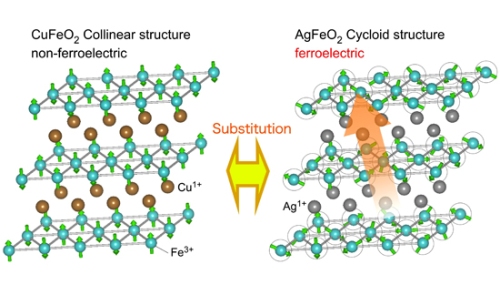A research team led by Dr. Noriki Terada from the Neutron Scattering Group of the Quantum Beam Unit at the National Institute for Materials Science (NIMS) and Dr. Yoshihiro Tsujimoto from the NIMS International Center for Materials Nanoarchitectonics (MANA) together with the University of Oxford and the Rutherford Appleton Laboratory has demonstrated that it is possible to largely control a magnetic material’s dielectric and magnetic properties by replacing nonmagnetic atoms with other atoms.

The magnetic dielectrics known as multiferroics could be used in a new kind of memory devices wherein an electric field controls magnetization and a magnetic field controls dielectric polarization, contrary to the traditional technology wherein an electric field controls dielectric polarization and a magnetic field controls magnetization. In recent times, scientists have looked for multiferroic materials that demonstrate immense ferroelectric polarization at room temperature. Since these materials are rare to find, development of new materials based on novel concepts is required.
Dr. Terada’s team utilized an ultra-high pressure synthesis device at NIMS to synthesize a superior quality AgFeO2 specimen, wherein the nonmagnetic Cu ions in the delafossite oxide CuFeO2 were totally replaced by Ag ions, and demonstrated the new material’s capability to show ferroelectric polarization in the absence of a magnetic field. Dr. Terada’s team together with a research team at the Rutherford Appleton Laboratory conducted high resolution neutron diffraction investigations on AgFeO2, and revealed the new material’s spin structure and crystal structure and elucidated the mechanism of ferroelectric polarization for the first time.
This work demonstrated the possibility of obtaining multiferroic properties through the replacement of nonmagnetic ions in a delafossite oxide by other nonmagnetic ions, thus providing a new idea to studies of room-temperature multiferroic. This breakthrough could be helpful in developing new energy conversion materials and next-generation large capacity memories.
Disclaimer: The views expressed here are those of the author expressed in their private capacity and do not necessarily represent the views of AZoM.com Limited T/A AZoNetwork the owner and operator of this website. This disclaimer forms part of the Terms and conditions of use of this website.